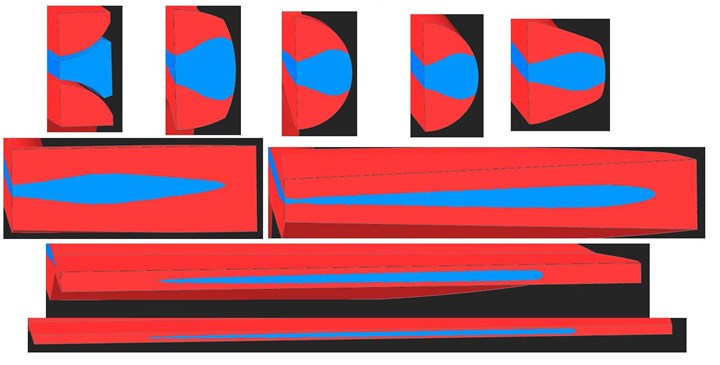Simulation Software Offers More Insights into Coextrusion, Layer Incapsulation
NPE2024: Compuplast to also debut simulation tools for blow molding and thermoforming.
Share
Compuplast North America is showcasing the latest releases of the Virtual Extrusion Laboratory 3D Module, which can now simulate coextrusion and show layer encapsulation. The accompanying image shows cuts in the flow field from the merge point to the die exit. Note how the middle layer deforms as it flows along and disappears in the center of the web (half symmetry analysis). Compuplast has also added the capability to predict the deformed shape of a profile in 3D.

Compuplast is also showing simulation products from Accuform. These include the fully 3D versions of its T-SIM (Thermoforming) and B-SIM (Blow Molding) simulation software. Prior versions used a “Mid-Plane” approximation of the polymer sheet or parison with 2D, triangular elements. The new 3D versions use layers of hexahedral (brick), elements to define the sheet. Compuplast is Accuform’s representative in North America.
Related Content
-
Medical Tubing: Use Simulation to Troubleshoot, Optimize Processing & Dies
Extrusion simulations can be useful in anticipating issues and running “what-if” scenarios to size extruders and design dies for extrusion projects. It should be used at early stages of any project to avoid trial and error and remaking tooling.
-
Troubleshooting Screw and Barrel Wear in Extrusion
Extruder screws and barrels will wear over time. If you are seeing a reduction in specific rate and higher discharge temperatures, wear is the likely culprit.
-
Part 2 Medical Tubing: Use Simulation to Troubleshoot, Optimize Processing & Dies
Simulation can determine whether a die has regions of low shear rate and shear stress on the metal surface where the polymer would ultimately degrade, and can help processors design dies better suited for their projects.







